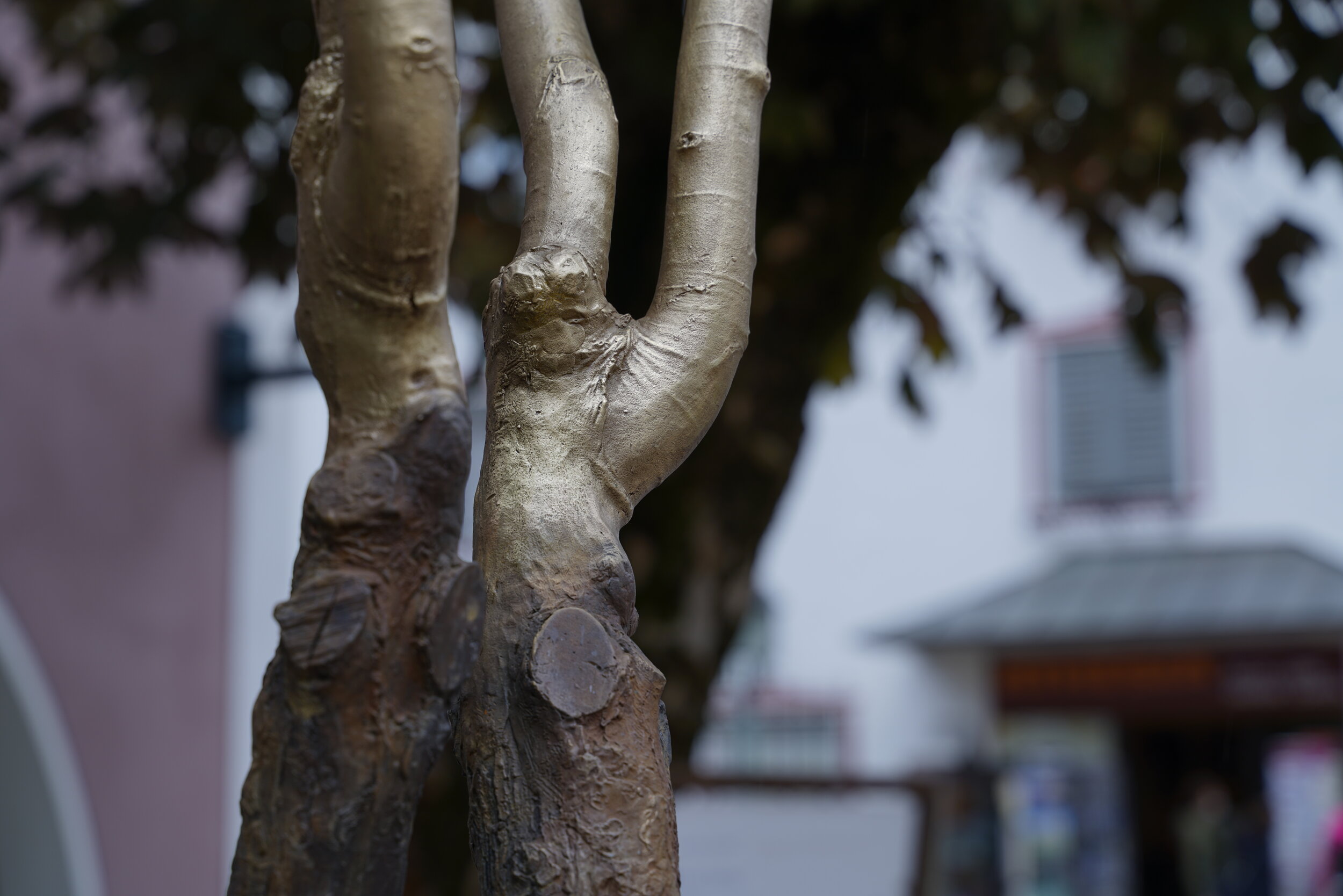
Aron Demetz
*1972, Val Gardena
lives and works in Val Gardena, Italy
EN
At the centre of Aron Demetz’(*1972, Val Gardena) sculptural work stands the life-size human figure made of wood, plaster or resin, sometimes charred. For the 7th edition of the Biennale Gherdëina he is exhibiting a new set of works in which the body loses its initial form and regrows into new ones. In this way, Demetz reflects on the creation of the world, the leitmotiv of the Biennale, by translating the delicate bond between human being and nature into fragile sculptures. Close to Restaurant Traube is his newly created and fragile bronze sculpture, which, in the sense of man‘s intervention in nature, deals with the guidelines of efficiency and artificiality. The hand-painted sculpture shows two towering branches of two tree species combined to each other, which were similarly connected during the grafting process of classical grafting and additionally mirrored identically to each other.
The works in the exhibition continue the question of the reduction and abstraction of sculpture. The viewer sees the production process of the bronze casting, with its filling spouts, risers and venting channels, in front of him. The actual sculpture is missing completely or remains hidden in the fireclay stone surrounding the casting. Demetz says that he is looking for the form in order to make the artistic process of casting visible as a hidden act, in order to extend the act of creation in this sense to the viewer. By directly addressing casting as an artistic act, he also gives his work process an intimate commentary on world creation as a sculptural approach to work.
IT
Al centro dell’esplorazione scultorea di Aron Demetz (*1972, Val Gardena) c’è la figura umana a grandezza naturale fatta di legno, gesso, resina o trattata col fuoco. Per la settima edizione della Biennale Gherdëina, l’artista espone un nuovo ciclo di opere in cui il corpo perde la sua forma iniziale ricrescendo secondo nuove forme. In questo modo, Demetz riflette sull’idea della creazione del mondo, leitmotiv della Biennale, traducendo il delicato legame tra uomo e natura in fragili sculture. Davanti al Ristorante Traube è stata collocata la sua nuova scultura in bronzo, che affronta l’artificialità e l’efficienza nell’ottica di un intervento dell’uomo sulla natura. La scultura mostra due imponenti rami di due specie diverse di alberi uniti tra loro, che erano stati collegati in modo simile durante il processo dell’innesto classico e che si specchiano ora simmetricamente l’uno nell’altro.
Le opere in mostra nella Sala Trenker rappresentano il continuo della ricerca che va verso l’astrazione e l’essenziale della scultura. Lo spettatore vede davanti a sé il processo di produzione della fusione in bronzo, con i suoi beccucci di riempimento, le alzate e i canali di sfiato. La scultura vera e propria manca completamente o rimane nascosta nelle forme di argilla della colatura del bronzo. Demetz dichiara di andare in cerca di queste forme per rendere visibile il processo artistico della fusione, una fase che di solito non vediamo, e rendere così partecipe lo spettatore nell’atto della creazione. La sua pratica mette quindi al centro non tanto l’opera, quanto la formazione dell’opera. Osservando le tracce di questo processo, Demetz offre così un contributo intimo e personale alla riflessione sulla creazione del mondo.
DE
Im Zentrum der skulpturalen Auseinandersetzung steht bei Aron Demetz (*1972, Gröden) die aus Holz oder Gips, mit Harz übergossene oder mit Feuer bearbeitete, lebensgroße menschliche Figur. Für die siebte Ausgabe der Biennale Gherdëina stellt er einen neuen Werkzyklus vor, in welchem er die Körper in ihrer ursprünglichen Form auflöst und in eine neue Form transformiert. Damit reflektiert er den Gedanken der Welterfindung als Leitmotiv der Biennale, indem er das sensible Band zwischen Mensch und Natur in fragile Skulpturen übersetzt. Unmittelbar in der Nähe des Restaurants Traube befindet sich seine neu geschaffene und fragile Bronzeskulptur, welche die Effizienz und Künstlichkeit des Eingreifens des Menschen in die Natur thematisiert. Die Skulptur zeigt zwei turmhohe Äste zweier kombinierter Baumarten, die, ähnlich wie beim klassischen Veredelungsvorgang des Pfropfens, miteinander verbunden und zusätzlich ident gespiegelt wurden.
Die Arbeiten in der Ausstellung im Trenker Saal setzen die Fragestellung der Reduktion und Abstraktion der Skulptur fort. Der Betrachter sieht den Produktionsprozess des Bronzegusses, mit seinen Füllstutzen, Steigern und Entlüftungskanälen. Die eigentliche Skulptur fehlt gänzlich oder bleibt im den Guss umschließenden Schamottstein verborgen. Demetz sagt hierzu, dass er nach der Form sucht, um den künstlerischen Prozess des Gießens als verborgenen Akt sichtbar zu machen, und den Entstehungsakt in diesem Sinne bis zum Betrachter zu verlängern. Indem er den Guss als künstlerischen Akt direkt thematisiert, erhebt er den Werkprozess zum Kommentar in Bezug auf eine Weltschöpfung als skulpturalen Prozess.




